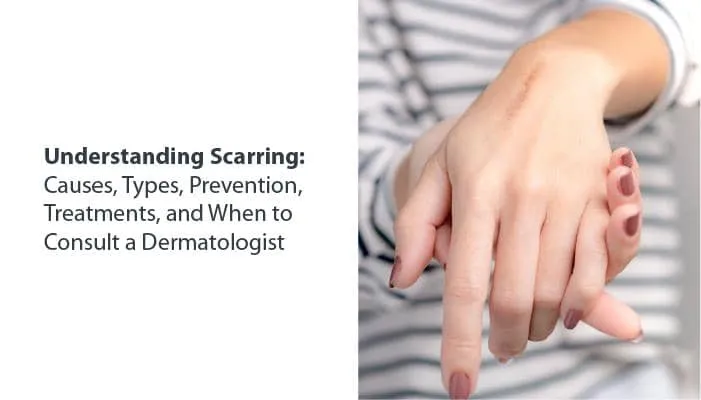Understanding Scarring: Causes, Types, Prevention, Treatments, and When to Consult a Dermatologist
October 4, 2023
Introduction of Scarring
The scarring as a common outcome of wound healing, where the skin's appearance and texture change permanently.
Here the blog will explain what scarring is, its causes, various types, preventive measures, available treatments, and when to seek professional guidance.
Understanding Scarring:
- What Is Scarring? Scarring as the body's natural response to wound healing, resulting in the formation of new tissue that can look and feel different from the surrounding skin.
- Types of Scars: There are different types, including hypertrophic scars, keloids, atrophic scars, and contracture scars.
Common Causes of Scarring:
- The common causes of scarring, such as cuts, burns, surgical incisions, acne, infections, and injuries.
- The depth, size, and location of the wound can influence the type and severity of the resulting scar.
Prevention of Scarring:
- Wound Care: The importance of proper wound care, including cleaning, disinfecting, and keeping the wound covered to reduce the risk of infection.
- Sun Protection: The use of sunscreen and protective clothing to shield healing wounds from UV exposure, which can darken scars.
- Avoiding Irritation: Advise against picking at scabs or wounds, which can lead to more significant scarring.
Treatment Options for Scarring:
Topical Products
Topical treatments containing ingredients like silicone, vitamin E, or corticosteroids that can help reduce the appearance of scars.
Laser Therapy
Laser treatments can improve the texture and color of scars.
Cryotherapy
Cryotherapy as a procedure involving freezing and removing scars.
Surgical Revision
The surgical options, such as scar excision or revision, which may be recommended for certain types of scars.
Dermal Fillers
Dermal fillers can help elevate and smooth atrophic scars.
When to Seek Professional Advice:
- Its important to consult a dermatologist or plastic surgeon if concerned about the appearance or discomfort of a scar.
- The professional guidance can help determine the most appropriate treatment approach.
Conclusion:
- The key takeaways, including the importance of wound care, sun protection, and consulting professionals for effective scar management.
- Everyone should prioritize proper wound healing and seek professional guidance when dealing with scarring concerns.
While the appearance of many scars can be significantly improved, complete removal may not always be possible, and the outcome depends on the type and severity of the scar.
Some natural remedies like aloe vera, vitamin E oil, or onion extract may help with scar reduction, but results can vary, and it's essential to consult a professional for personalized advice.
NOTICE BOARD
CONTACT US
CONTACT US
 Book Appointment
Book Appointment


.svg)
.svg)
.svg)
.svg)








